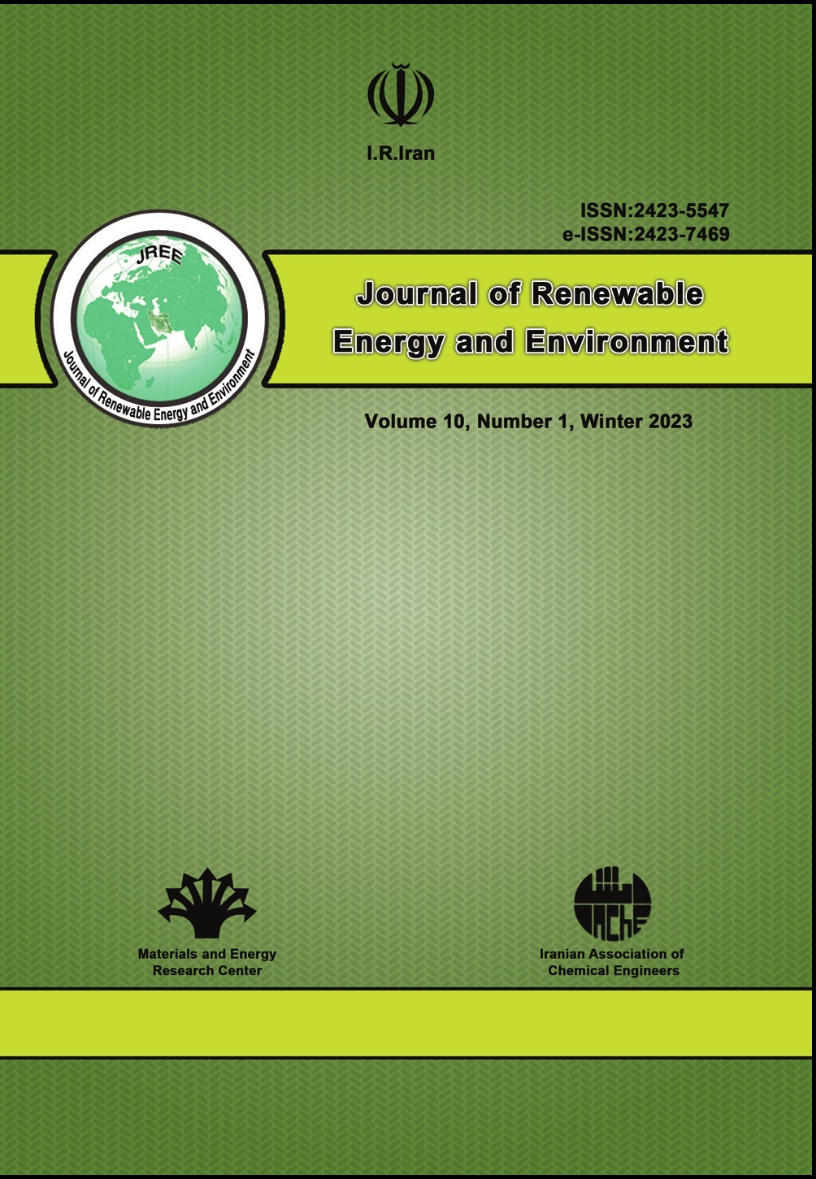Document Type : Technical Note
Authors
Institute of Solar Energy, Shanghai University of Electric Power, P. O. Box: 200090, Shanghai, China.
Abstract
This study aims to assess the potential of coupling solar PV power plants with Battery Energy Storage System (BESS) to curtail load-shedding and provide a stable and reliable baseload power generation in Zimbabwe. Data from geographical surveys, power plant proposals, and investment information from related sources were reviewed and applied accordingly. Areas considered to be of good potential to employ the use of BESS were identified considering such factors as feasibility of PV plants, proximity to transmission lines, the size of a town or neighborhood, and energy demands for BESS Return On Investment (ROI) calculations. Previous studies have proven that 10% of the suitable land for PV systems has the capability to generate thirty times the current power demand of the nation operating even with the least efficiency. In recent years, coupling renewable energy sources with a suitable energy storage system yielded improved performances, giving consumers a reliable, stable, and predictable grid. BESS technologies on the utility scale have improved in recent years, giving more options with improved safety, and decreasing the purchase costs, too.
Keywords
- Battery Energy Storage System
- Solar Photovoltaic
- BESS Investments
- Levelized Cost of Energy Storage
- Lithium-Iron Phosphate
- Zimbabwe
Main Subjects
- "Zimbabwe set for real solar growth", (2020). (https://www.pv-magazine.com/2020/01/24/zimbabwe-set-for-real-solar-growth/), (Accessed: 24 Jan. 2020).
- Jones, D., "Refurbishment delays hamper Zimbabwe energy prospects", (2021). (https://allafrica.com/stories/202105200809.html#:~:text=Victoria%20Falls%20—%20THE%20expansion%20of,release%20finances%20to%20the%20contractor), (Accessed: 20 May 2021).
- World Bank, "Global solar atlas 2.0", Solar resource data: Solargis, (2019). (https://xs.studiodahu.com/scholar?q=Global+Solar+Atlas+2.0%2C+Solar+resource+data%2C+Solargis)
- Menictas, C., Skyllas-Kazacos, M. and Mariana Lim, T., "Advances in batteries for medium and large-scale energy storage", Elsevier Ltd., (2014), 563-586. (https://doi.org/10.1016/C2013-0-16429-X).
- Handbook on battery energy storage system, (2018). (https://dx.doi.org/10.22617/TCS189791-2), (Accessed: Dec. 20218).
- Energy storage impacts of electrochemical utility-scale battery energy storage systems on the bulk power system, (2021), 5-12. (https://www.readkong.com/page/energy-storage-impacts-of-electrochemical-utility-scale-1520315).
- DiOrio, N., Dobos, A. and Janzou, S., "Economic analysis case studies of battery energy storage with SAM", (2015), 5-7. (https://www.nrel.gov/docs/fy16osti/64987.pdf).
- Battery University, "Types of lithium-ion", (2015). (https://batteryuniversity.com/article/bu-205-types-of-lithium-ion).
- Curry, C., "Lithium-ion battery costs and market", (2017). (https://data.bloomberglp.com/bnef/sites/14/2017/07/BNEF-Lithium-ion-battery-costs-and-market.pdf), (Accessed: 4 Jul. 2017).
- Ioakimidis, C.S., Murillo-Marrodán, A., Bagheri, A., Thomas, D. and Genikomsakis, K.N., "Life cycle assessment of a lithium iron phosphate (LFP) electric vehicle battery in second life application scenarios", Sustainability, Vol. 11, No. 9, (2019). (https://doi.org/10.3390/su11092527).
- Accardo, A., Dotelli, G., Musa, M.L. and Spessa, E., "Life cycle assessment of an NMC battery for application to electric light-duty commercial vehicles and comparison with a sodium-nickel-chloride battery", Applied Sciences, Vol. 11, No. 3, (2021). (https://doi.org/10.3390/app11031160).
- Andrey, A. and Anna, P., "Efficient energy management and energy saving with a BESS (Battery Energy Storage System)", (2021). (https://www.integrasources.com/blog/energy-management-and-energy-saving-bess/), (Accessed: 16 Aug. 2021).
- Tumino, P., "The architecture of battery energy storage systems", (2020). (https://eepower.com/technical-articles/the-architecture-of-battery-energy-storage-systems/), (Accessed: 23 Sep. 2020).
- Xavier, L.S., Amorim, W., Cupertino, A.F., Mendes, V.F., do Boaventura, W.C. and Pereira, H.A., "Power converters for battery energy storage systems connected to medium voltage systems: A comprehensive review", BMC Energy, Vol. 7, No. 4 (2019), 1778-1790. (https://doi.org/10.1186/s42500-019-0006-5).
- "Life cycle of lithium iron phosphate batteries". (https://www.powertechsystems.eu/home/tech-corner/lithium-iron-phosphate-lifepo4/).
- Pterra, "Technical aspects of battery energy storage systems for integration in distribution circuits in New York state", (2019). (https://www.pterra.com/distribution-systems/technical-aspects-of-battery-energy-storage-systems-for-integration-in-distribution-circuits-in-new-york-state/), (Accessed: 13 Feb. 2019).
- "Practical considerations for siting utility-scale battery projects", (2016). (https://www.powermag.com/practical-considerations-siting-utility-scale-battery-projects/), (Accessed: 1 May 2016).
- Alzahrani, A., Alharthi, H. and Khalid, M., "Minimization of power losses through optimal battery placement in a distributed network with high penetration of photovoltaics", Energies, Vol. 13, No. 1, (2019). (https://doi.org/10.3390/en13010140).
- "Grid-scale battery storage", (2019). (https://www.nrel.gov/docs/fy19osti/74426.pdf), (Accessed: Sep. 2019).
- "Determine optimal sites project size, technology and economics for utility-scale (generation+) battery system deployment", (2019). (https://www.irena.org//media/Files/IRENA/Agency/Publication/2019/Sep/IRENA_Utility-scale-batteries_2019.pdf).
- Advanced lithium-ion battery research and development. (https://materials.waters.com/li-ion/).
- Cole, W., Frazier, W.A. and Augustine, C., Cost" projections for utility-scale battery storage: 2021 update", National Renewable Energy Laboratory, (2021). (https://www.nrel.gov/docs/fy21osti/79236.pdf), (Accessed: Jun. 2016).
- Samu, R., Fahrioglu, M. and Ozansoy, C., "The potential and economic viability of wind farms in Zimbabwe", International Journal of Green Energy, Vol. 16, No. 15, (2019), 1539-1546. (https://doi.org/10.1080/15435075.2019.1671424).
- Denholm, P., Sun, Y. and Mai, T., "An introduction to grid services: Concepts, technical requirements, and provision from wind", Golden, CO: National Renewable Energy Laboratory, (2019), 1-52. (https://doi.org/10.2172/1493402).
- Battery Energy Storage Systems (BESS): Ancillary services and beyond, (2018). (https://innovationweek.irena.org/-/media/Files/IRENA/Innovation-Week/SessionalDocuments/IRENA-IW18--Electricity-storage--01---Duboviks--BESS--06-Sept-2018.pdf), (Accessed: 6 Sep. 2018).
- Ibrahim, H. and Ilinca, A., "Techno-economic analysis of different energy storage technologies", In Energy Storage: Technologies and Applications, edited by Ahmed Zobaa, (2013). (https://doi.org/10.5772/52220).
- Why battery management systems are important in lithium iron phosphate batteries, (2018). (https://relionbattery.com/blog/why-battery-management-systems-are-important-in-lithium-iron-phosphate-batteries), (Accessed: 27 Nov. 2018).
- DiOrio, N., Dobos, A., Janzou, S., Nelson, A. and Lundstrom, B., "Techno-economic modelling of battery energy storage in SAM", (2015), 1-36. (https://doi.org/10.2172/1225314).

